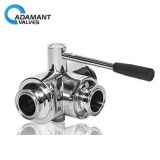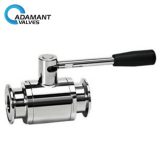Pneumatic sanitary ball valve evolves from plug valve. They have the same rotation of 90 degrees. The difference is that the plug valve body is a sphere, and there’s a circular hole or channel through its axis. The ratio of the sphere to the channel opening should be like this: when the ball rotates 90 degrees, the sphere should be present at the inlet and the outlet, therefore shutting off the flow. This type of valve can be installed anywhere in the pipeline.
Pneumatic sanitary ball valve only needs to use pneumatic actuator to drive the valve body for 90-degree rotation to achieve the function of shutting off and connecting the medium flow. In addition, it only takes a very small rotating torque to get it tightly closed. A fully equal valve body cavity provides the medium with a flow channel that has a very small resistance and is straight-through. Ball valves are generally considered to be most suitable for direct opening and closing, but recent developments have designed the ball valve into providing functions like throttling and flow control. Ball valve is characterized by its compact structure, easy operation and maintenance, suitability for water, solvents, acids, natural gas and other general working medium, as well as for media in poor working conditions, such as oxygen, hydrogen peroxide, methane and ethylene. Ball valve body can be integrated or assembled.



